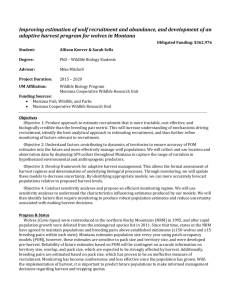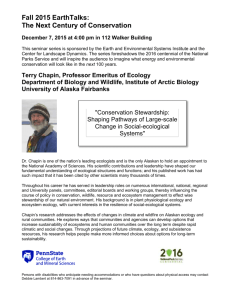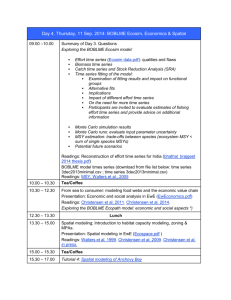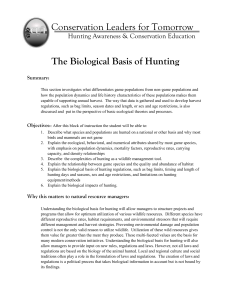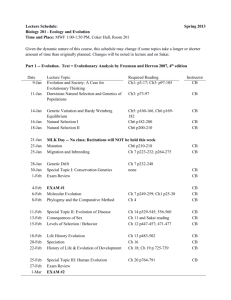At K
advertisement
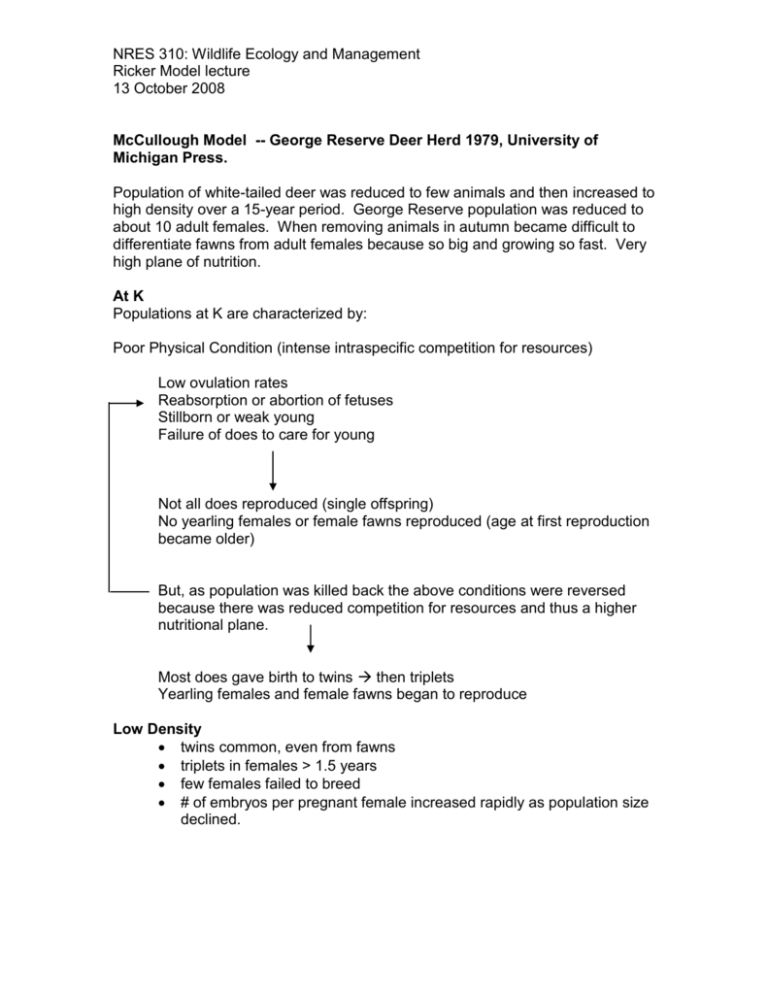
NRES 310: Wildlife Ecology and Management Ricker Model lecture 13 October 2008 McCullough Model -- George Reserve Deer Herd 1979, University of Michigan Press. Population of white-tailed deer was reduced to few animals and then increased to high density over a 15-year period. George Reserve population was reduced to about 10 adult females. When removing animals in autumn became difficult to differentiate fawns from adult females because so big and growing so fast. Very high plane of nutrition. At K Populations at K are characterized by: Poor Physical Condition (intense intraspecific competition for resources) Low ovulation rates Reabsorption or abortion of fetuses Stillborn or weak young Failure of does to care for young Not all does reproduced (single offspring) No yearling females or female fawns reproduced (age at first reproduction became older) But, as population was killed back the above conditions were reversed because there was reduced competition for resources and thus a higher nutritional plane. Most does gave birth to twins then triplets Yearling females and female fawns began to reproduce Low Density twins common, even from fawns triplets in females > 1.5 years few females failed to breed # of embryos per pregnant female increased rapidly as population size declined. NRES 310: Wildlife Ecology and Management Ricker Model lecture 13 October 2008 K need not be known in advance K/2 Recruitment Rate (Young / adults) K Population Size a = rmax for that environment (r changes all along the line, but models assume r is constant, need to use rmax). Regression Line Recruitment Rate (No. Young / No. Adults Rate x Population Size = Number K/2 or MSY K Extremely high rate of reproduction Population Size From this example K and a can be calculated with simple regression. Regression line calculated as Y = a + bX Where b = slope a = y-intercept, basically rmax for that environment, constant at x=0. K = intercept at Y = 0, These are nutritional models: As population size increases nutrition per individual decreases. young fostered / adult also decreases NRES 310: Wildlife Ecology and Management Ricker Model lecture 13 October 2008 As push population size away from K body condition increases as intraspecific condition decreases age first reproduction decreases higher conception and ovulation rates low density, fawns begin reproducing and often have twins very low density does begin having triplets animals in phenomenal shape! Cannot assess populations in different areas using the same criteria. K differs between populations so you cannot directly compare them! (same population size is different density with respect to K). For example: Population Size 200 300 400 K 200 300 400 No. Dying 20 30 40 10 % dying. When plot mortality rate v. population size. You would conclude populations are density independent, although in reality all are at K and showing strong density dependence Mortality Rate Population Size May compare populations that show density independent growth. Changes in mean generation time, litter size etc. things that are relatively fixed in density dependent organisms. So then we graph number of adults against recruitment number. NRES 310: Wildlife Ecology and Management Ricker Model lecture 13 October 2008 highest number of recuits into the MSY population because relatively high r and larger number of animals producing offspring. FRY Number of Fawns K Population Size High reproductive rate, but very small population size High population size, but low reproductive rate with very few young MSY maximum sustained yield – maximum harvest that you can remove from the population without leading to extirpation. Basically this is an interaction between population size and per captia recruitment. FRY fixed removal yield – NOT mathematically determined. Difficult to precisely measure MSY so when setting harvest back off MSY to FRY on the right size of the parabola (if on left can lead to extirpation of the population). Where people push harvest to MSY the effort to "bag " an animal increases (I.e. more time is required because don't see many animals running around). So hunter satisfaction drops (too much work) often public perception is more important which is another reason to be between FRY and K. closer to K see more animals running around. Effects in density dependent systems are very different from density independent. Discuss male v. female harvest to where populations are, on this curve, with respect to K and how you are going to affect growth of populations by harvest single or both sexes. NRES 310: Wildlife Ecology and Management Ricker Model lecture 13 October 2008 Harvest determines the surplus and varies uniquely with it. MSY Number of Fawns Additive mortality Compensatory mortality Population Size K Management works well from MSY to K, not between 0 and MSY. Density independent (draw) IF mortality is compensatory surplus determines the harvest. Some environmental perturbations causes the population to crash Compensatory Mortality Surplus – Leopold termed the "harvestable surplus" – true if mortality is compensatory. So the amount number of animals above the refuge line can be harvested (i.e. surplus) N Refuge Effect T NRES 310: Wildlife Ecology and Management Ricker Model lecture 13 October 2008 Ricker Curve K 45 Line of no population growth MSY Nt+1 Equal increments on X and Y axes Nt Nice way to project population growth between one year and next. In McCulloughs models Nt is "prehunt population" and Nt+1 is post hunt population. Directly determine recruits and harvest of population. NRES 310: Wildlife Ecology and Management Ricker Model lecture 13 October 2008 Characteristics of Population Pop. Pop No Not @ @ Diff. enough MSY K info Population with highest recruitment of √ fawns Population with largest no. of animals √ Average size of animals will be smaller √ Age at first breeding, of females, will be √ younger √ Individuals more vulnerable to predators √ Highest breeding potential √ Best management Availability of food greatest √ NRES 310: Wildlife Ecology and Management Ricker Model lecture 13 October 2008 AGE STRUCTURE AND POPULATION DENSITY 5–6 M SY 4–5 3–4 1–2 Number of female Fawns K 0–1 EXPANDING Population Size Size 5–6 4–5 3–4 RR 1–2 K 0–1 STATIONARY 5–6 4–5 3–4 1–2 0–1 DECLINING Population Size

